Chemical Composition and Antioxidant and Antibacterial Activities of an Essential Oil Extracted from an Edible Seaweed, Laminaria japonica L.
Abstract
:1. Introduction
2. Results and Discussion
2.1. Chemical Composition of LJEO
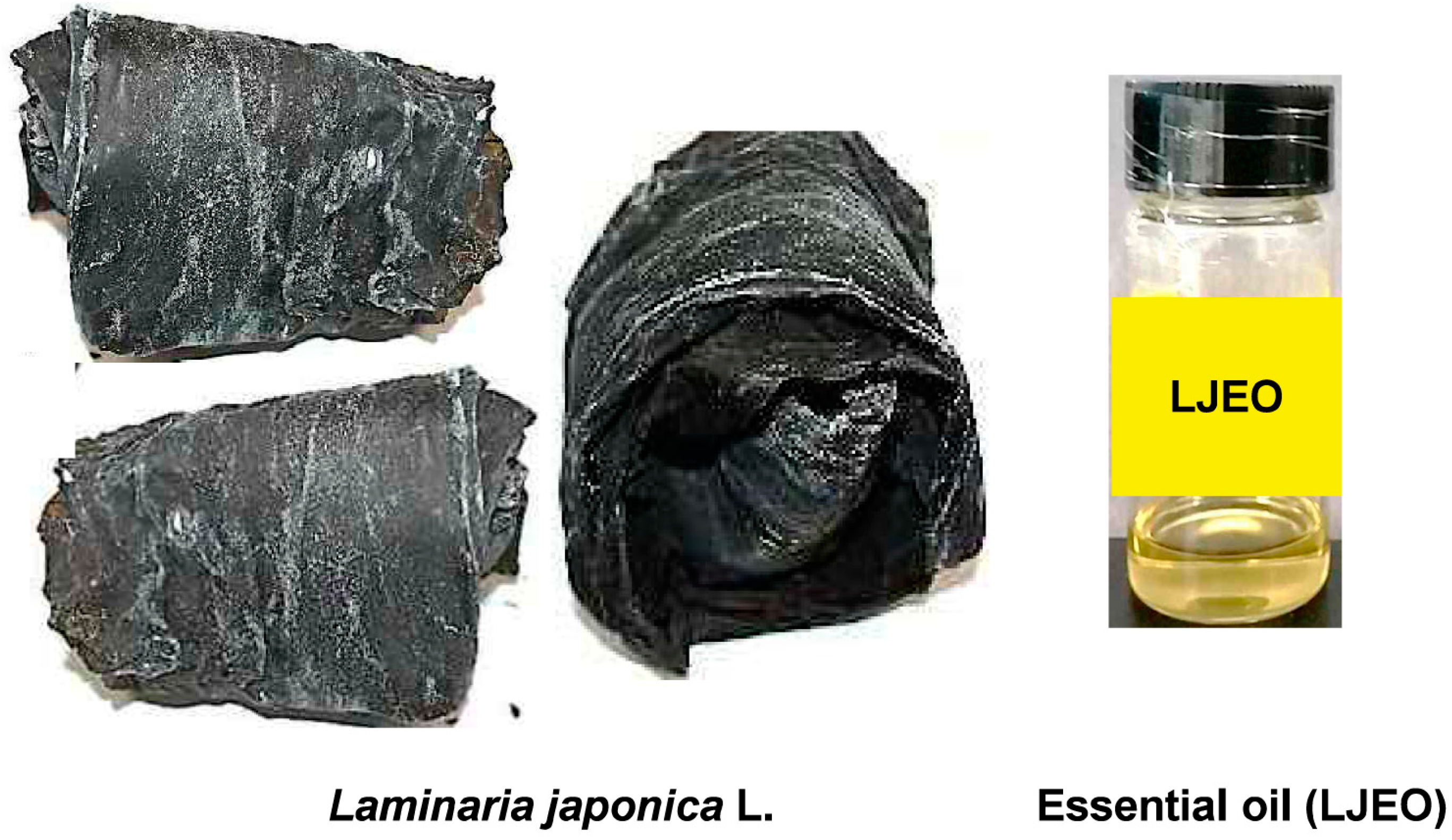
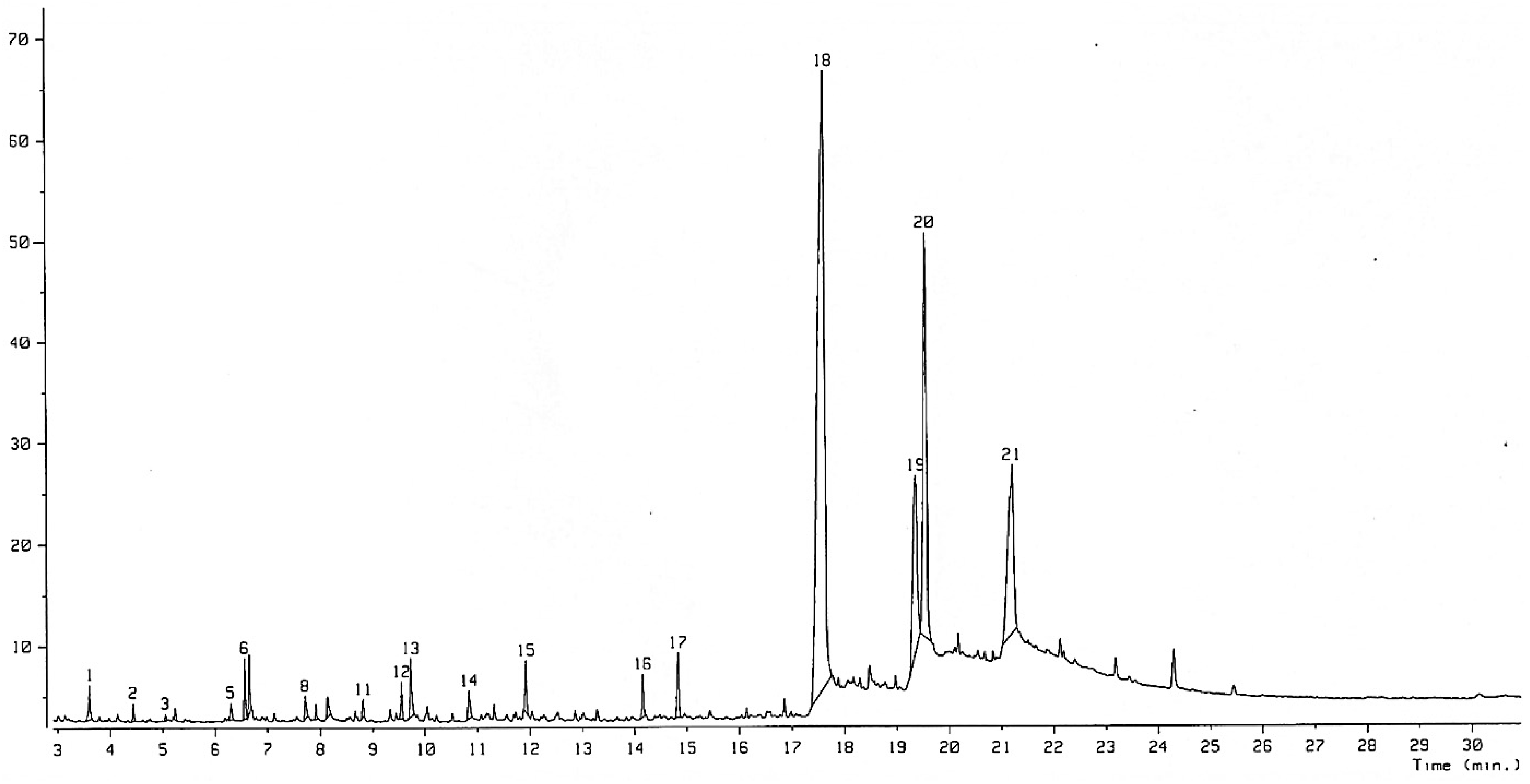
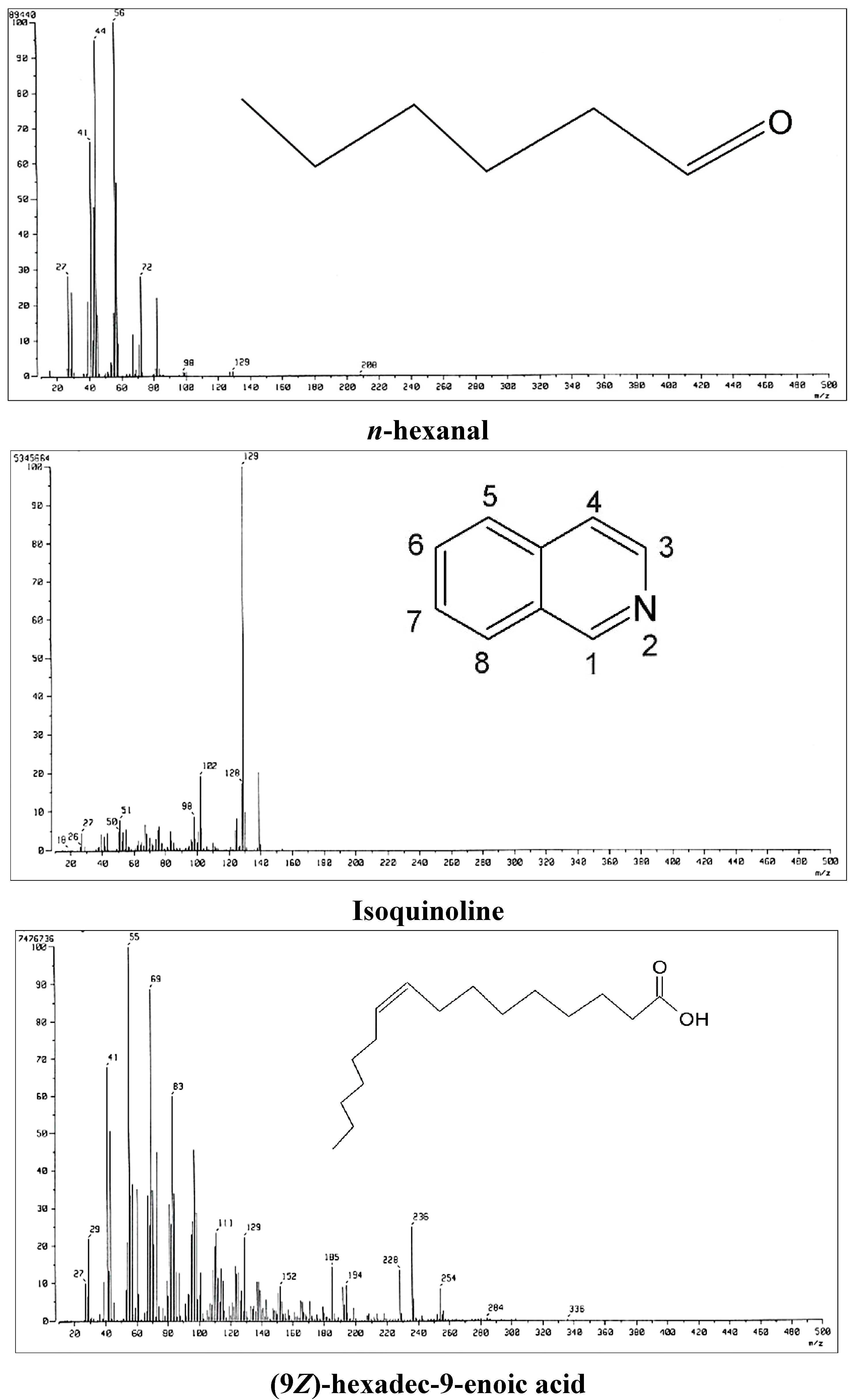
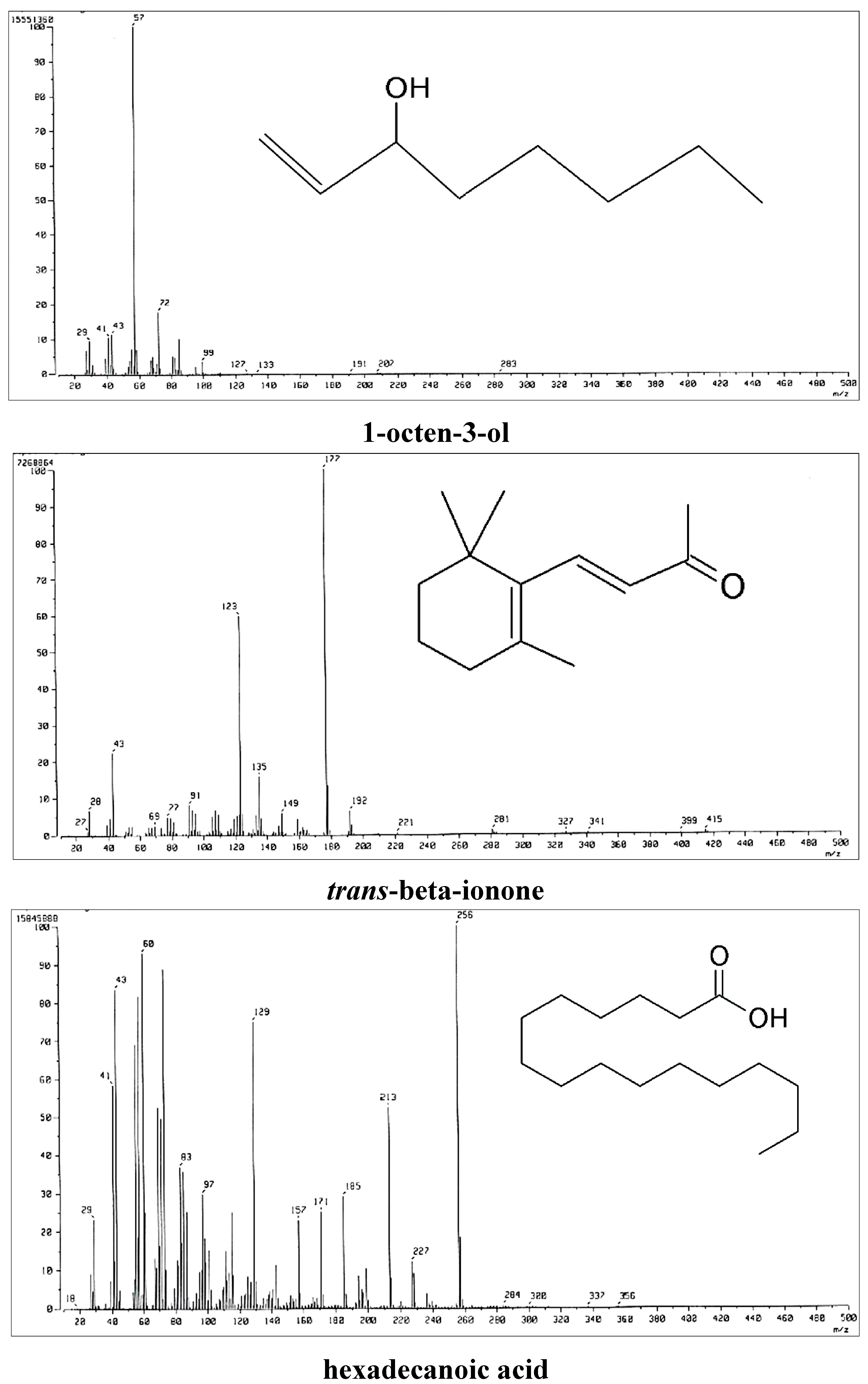
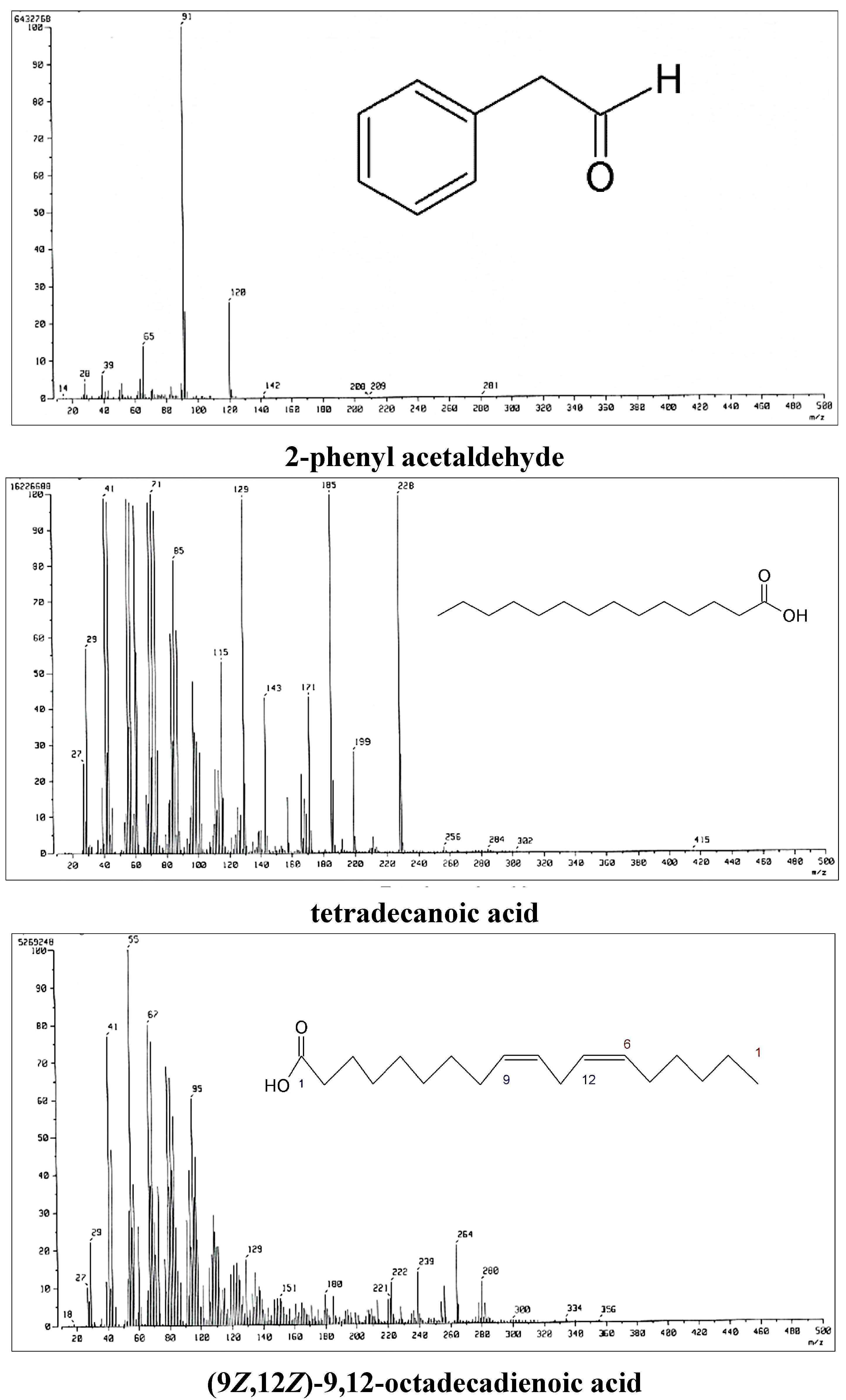
| Functional Group | No. * | SI ** | RT *** | Compound # | Composition (%) |
|---|---|---|---|---|---|
| Aldehyde | 1 | 892 | 3.60 | n-hexanal | 0.63 |
| 4 | 900 | 5.23 | n-heptanal | 0.19 | |
| 5 | 887 | 6.30 | benzaldehyde | 0.32 | |
| 8 | 812 | 7.71 | 2-phenyl acetaldehyde | 0.47 | |
| 9 | 845 | 7.91 | trans-2-octenal | 0.21 | |
| 12 | 864 | 9.54 | trans-2-nonenal | 0.56 | |
| Ketone | 3 | 874 | 5.05 | Heptan-2-one | 0.09 |
| 6 | 825 | 6.56 | 1-octen-3-one | 0.88 | |
| 11 | 594 | 8.81 | Heptan-2-one | 0.28 | |
| 16 | 751 | 14.16 | trans-beta-ionone | 0.78 | |
| 17 | 900 | 14.84 | 2(4H)-benzofuranone | 1.40 | |
| Alcohol | 2 | 884 | 4.43 | 2-hexen-1-ol | 0.24 |
| 7 | 882 | 6.65 | 1-octen-3-ol | 0.85 | |
| 10 | 717 | 8.13 | 2-octen-1-ol | 0.50 | |
| 13 | 824 | 9.73 | trans-2-undecen-1-ol | 1.33 | |
| Fatty acid | 18 | 815 | 17.64 | tetradecanoic acid (myristic acid) | 51.75 |
| 19 | 749 | 19.37 | (9Z)-hexadec-9-enoic acid (palmitoleic acid) | 9.25 | |
| 20 | 812 | 19.57 | hexadecanoic acid (palmitic acid) | 16.57 | |
| 21 | 624 | 21.22 | (9Z,12Z)-9,12-Octadecadienoic acid (linoleic acid) | 12.09 | |
| Benzypyridine | 14 | 621 | 10.84 | isoquinoline | 0.66 |
| Monoterpene | 15 | 507 | 11.92 | isocineole | 0.95 |
2.2. Antibacterial Activity of LJEO against Foodborne Pathogens
| Foodborne Pathogens | LJEO # | Positive Control *,# | Negative Control **,# | MIC | MBC |
|---|---|---|---|---|---|
| S. aureus ATCC 49444 | 11.5 ± 0.58 bc | 13.0 ± 2.64 a | 0 ± 0 | 25 | 25 |
| B. cereus ATCC 10876 | 10.5 ± 0.57 c | 12.0 ± 1.52 ab | 0 ± 0 | 25 | 25 |
| E. coli O157:H7 ATCC 43890 | 0 ± 0 d | 12.0 ± 2.08 ab | 0 ± 0 | 0 | 0 |
2.3. Free Radical Scavenging and Antioxidant Activity of LJEO
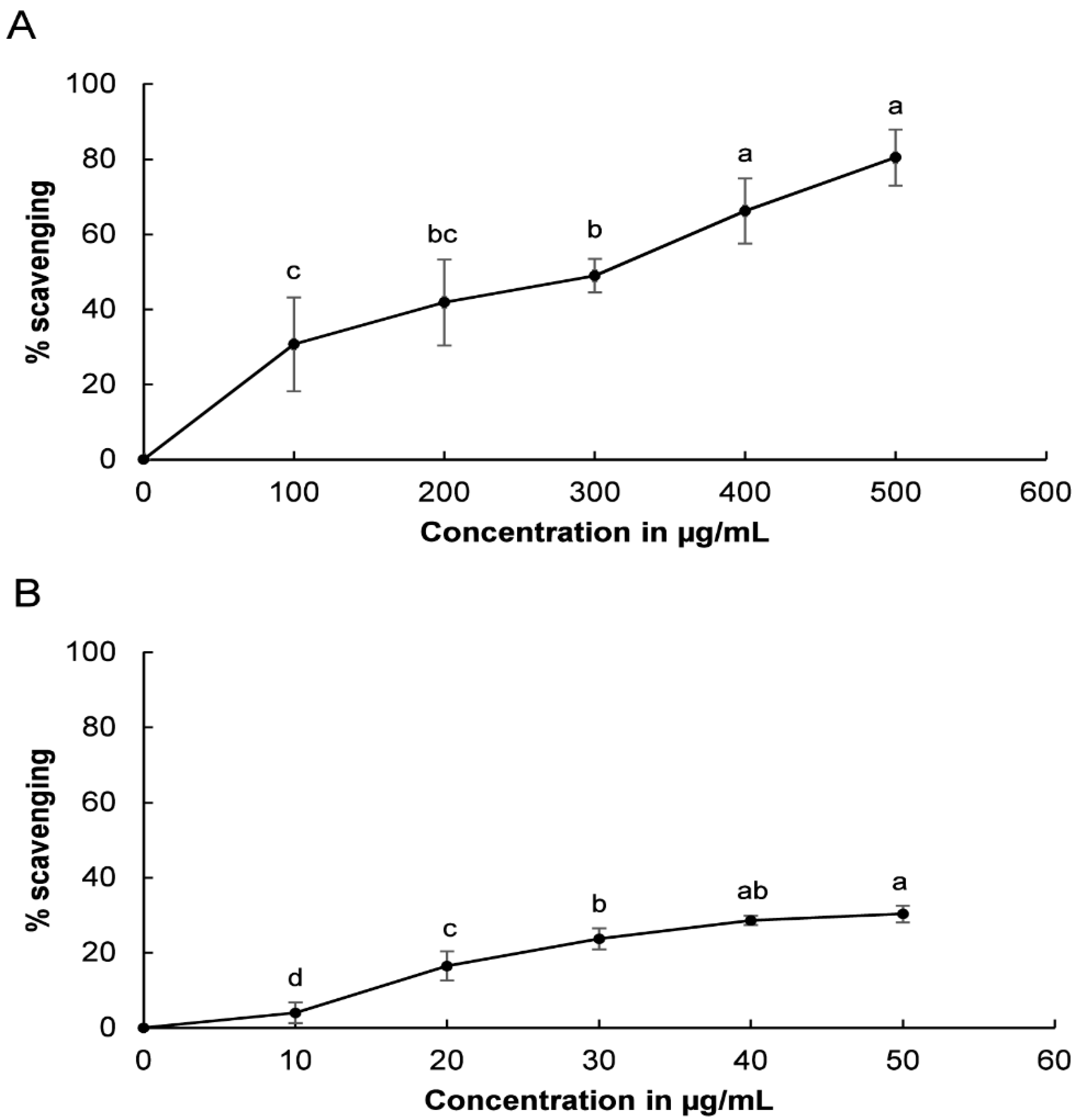
| Extract | ABTS Radical Scavenging (IC50) * | Hydroxyl Radical Scavenging (IC50) * | Inhibition of Lipid Peroxidation (IC50) * | Reducing Power (IC0.5) ** | Phenol Content (% Gallic Acid Equivalent) |
|---|---|---|---|---|---|
| LJEO | 92.98 ± 1.69 | 158.18 ± 3.55 | 388.35 ± 3.07 | 89.35 ± 2.02 | 5.81 ± 0.60 |
| BHT | 19.65 ± 0.43 | 19.85 ± 1.35 | 35.16 ± 1.15 | 12.74 ± 1.41 |
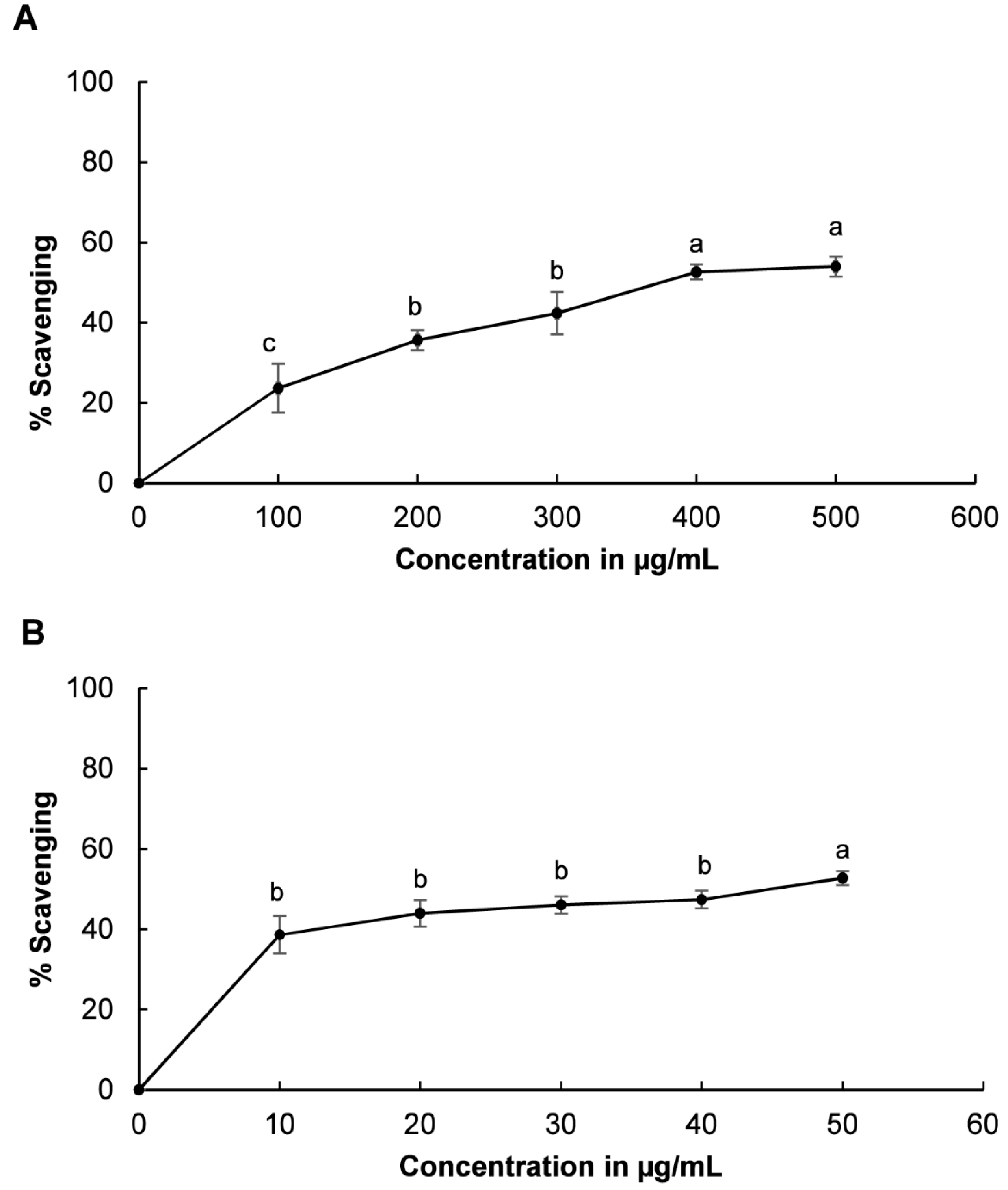
3. Experimental Section
3.1. Extraction of Essential Oil from L. japonica and Analysis
3.2. GC-MS Analysis of LJEO
3.3. Evaluation of Antibacterial Activity of LJEO
3.3.1. Pathogenic Bacteria Used
3.3.2. Antibacterial Evaluation
3.3.3. Determination of Minimum Inhibitory Concentration (MIC) and Minimum Bactericidal Concentration (MBC)
3.4. Free Radical Scavenging and Antioxidant Potential of LJEO
3.4.1. DPPH Free Radical Scavenging Assay
3.4.2. Superoxide Radical Scavenging Assay
3.4.3. ABTS Radical Scavenging Assay
3.4.4. Hydroxyl Radical Scavenging Assay
3.4.5. Inhibition of Lipid Peroxidation
3.4.6. Reducing Power Assay
3.4.7. Total Phenolic Content
3.5. Statistical Analysis
4. Conclusions
Acknowledgments
Author Contributions
Conflict of Interest
References
- Cai, Y.; Luo, Q.; Sun, M.; Corke, H. Antioxidant activity and phenolic compounds of 112 traditional Chinese medicinal plants associated with anticancer. Life Sci. 2004, 74, 2157–2184. [Google Scholar] [CrossRef] [PubMed]
- Ghasemi Pirbalouti, A.; Siahpoosh, A.; Setayesh, M.; Craker, L. Antioxidant activity, total phenolic and flavonoid contents of some medicinal and aromatic plants used as herbal teas and condiments in Iran. J. Med. Food 2014, 17, 1151–1157. [Google Scholar] [CrossRef] [PubMed]
- Poulson, H.E.; Prieme, H.; Loft, S. Role of oxidative DNA damage in cancer initiation and promotion. Eur. J. Cancer Prev. 1998, 7, 9–16. [Google Scholar]
- Yanishlieva, N.V.; Marinova, E.Y.; Pokorny, J. Natural antioxidants from herbs and spices. Eur. J. Lipid Sci. Technol. 2006, 108, 776–793. [Google Scholar] [CrossRef]
- Sundarammal, S.; Thirugnanasampandan, R.; Selvi, M.T. Chemical composition analysis and antioxidant activity evaluation of essential oil from Orthosiphon thymiflorus (Roth) Sleesen. Asian Pac. J. Trop. Biomed. 2012, 2, S112–S115. [Google Scholar] [CrossRef]
- Dubey, D.; Prashant, K.; Jain, S.K. In-vitro antioxidant activity of the ethyl acetate extract of gum guggul (Commiphora mukul). Biol. Forum Int. J. 2009, 1, 32–35. [Google Scholar]
- Velioglu, Y.S.; Mazza, G.; Gao, L.; Oomah, B.D. Antioxidant activity and total phenolics in selected fruits, vegetables, and grain products. J. Agriic. Food Chem. 1998, 46, 4113–4117. [Google Scholar] [CrossRef]
- Thitilertdecha, N.; Teerawutgulrag, A.; Rakariyatham, N. Antioxidant and antibacterial activities of Nephelium lappaceum L. extracts. LWT Food Sci. Technol. 2008, 41, 2029–2035. [Google Scholar] [CrossRef]
- Kim, J.; Marshall, M.R.; Wei, C. Antibacterial activity of some essential oil components against five foodborne pathogens. J. Agric. Food Chem. 1995, 43, 2839–2845. [Google Scholar] [CrossRef]
- Faid, M. Antimicrobials from marine algae. In Natural Antimicrobials in Food Safety and Quality; Rai, M., Chikindas, M., Eds.; CAB International: Wallingford, UK, 2011; pp. 95–103. [Google Scholar]
- Patra, J.K.; Das, G.; Baek, K.H. Antibacterial mechanism of the action of Enteromorpha linza L. essential oil against Escherichia coli and Salmonella Typhimurium. Bot. Stud. 2015, 56, 1–9. [Google Scholar] [CrossRef]
- Conforti, F.; Menichini, F.; Formisano, C.; Rigano, D.; Senatore, F.; Arnold, N.A.; Piozzi, F. Comparative chemical composition, free radical-scavenging and cytotoxic properties of essential oils of six Stachys species from different regions of the Mediterranean area. Food Chem. 2009, 116, 898–905. [Google Scholar] [CrossRef]
- Bardaweel, S.K.; Tawaha, K.A.; Hudaib, M.M. Antioxidant, antimicrobial and antiproliferative activities of Anthemis palestina essential oil. BMC Complement. Altern. Med. 2014, 14, 297. [Google Scholar] [CrossRef] [PubMed]
- Patra, J.K.; Kim, S.H.; Baek, K.H. Antioxidant and free radical-scavenging potential of essential oil from Enteromorpha Linza L. prepared by microwave-assisted hydrodistillation. J. Food Biochem. 2015, 39, 80–90. [Google Scholar] [CrossRef]
- Mothana, R.A.; AI-Said, M.S.; AI-Yahya, M.A.; AI-Rehaily, A.J.; Khaled, J.M. GC and GC/MS analysis of essential oil composition of the endemic soqotraen Leucas virgate Balf.f. and its antimicrobial and antioxidant activities. Int. J. Mol. Sci. 2013, 14, 23129–23139. [Google Scholar] [CrossRef] [PubMed]
- Roh, J.; Shin, S. Antifungal and antioxidant activities of the essential oil from Angelica koreana Nakai. Evid. Based Complement. Altern. Med. 2014, 2014. [Google Scholar] [CrossRef] [PubMed]
- Kim, S.K.; Bhatnagar, I. Physical, chemical, and biological properties of wonder kelp-Laminaria. Adv. Food Nutr. Res. 2011, 64, 85–96. [Google Scholar] [PubMed]
- Makarenkova, I.D.; Deriabin, P.G.; Lvov, D.K.; Zviagintseva, T.N.; Besednova, N.N. Antiviral activity of sulfated polysaccharide from the brown algae Laminaria japonica against avian influenza A (H5N1) virus infection in the cultured cells. Voprsy Virusol. 2010, 55, 41–45. [Google Scholar]
- Spavieri, J.; Allmendinger, A.; Kaiser, M.; Casey, R.; Hingley-Wilson, S.; Lalvani, A.; Guiry, M.D.; Blunden, G.; Tasdemir, D. Antimycobacterial, antiprotozoal and cytotoxic potential of twenty-one brown algae (Phaeophyceae) from British and Irish waters. Phytother. Res. 2010, 24, 1724–1729. [Google Scholar] [CrossRef] [PubMed]
- Cortesa, Y.; Hormazabalb, E.; Lealc, H.; Urzuad, A.; Mutisb, A.; Parrab, L.; Quiroz, A. Novel antimicrobial activity of a dichloromethane extract obtained from red seaweed Ceramium rubrum (Hudson) (Rhodophyta: Florideophyceae) against Yersinia ruckeri and Saprolegnia parasitica, agents that cause diseases in salmonids. Electron. J. Biotechnol. 2014, 17, 126–131. [Google Scholar] [CrossRef]
- Moorthi, P.V.; Balasubramanian, C. Antimicrobial properties of marine seaweed, Sargassum muticum against human pathogens. J. Coast. Life Med. 2015, 3, 122–125. [Google Scholar]
- Yuan, Y.V.; Walsh, N.A. Antioxidant and antiproliferative activities of extracts from a variety of edible seaweeds. Food Chem. Toxicol. 2006, 44, 1144–1150. [Google Scholar] [CrossRef] [PubMed]
- Li, L.Y.; Li, L.Q.; Guo, C.H. Evaluation of in vitro antioxidant and antibacterial activities of Laminaria japonica polysaccharides. J. Med. Plants Res. 2010, 4, 2194–2198. [Google Scholar]
- Kim, Y.H.; Kim, J.H.; Jin, H.J.; Lee, S.Y. Antimicrobial activity of ethanol extracts of Laminaria japonica against oral microorganisms. Anaerobe 2013, 21, 34–38. [Google Scholar] [CrossRef] [PubMed]
- Go, H.; Hwang, H.J.; Nam, T.J. A glycoprotein from Laminaria japonica induces apoptosis in HT-29 colon cancer cells. Toxicol. Vitro 2010, 24, 1546–1553. [Google Scholar] [CrossRef] [PubMed]
- Russell, M. GRAS Notice 000123. Available online: http://www.fda.gov/downloads/Food/IngredientsPackagingLabeling/GRAS/NoticeInventory/UCM261583 (accessed on 23 June 2015).
- Iqbal, P.J. Phytochemical screening of certain plant species of Agra city. J. Drug Deliv. Ther. 2012, 2, 135–138. [Google Scholar]
- Neumeyer, J.L.; Weinhardt, K.K. Isoquinolines. 2.3-(Dialkylaminoalkylamino) isoquinolines as potential antimalarial drugs. J. Med. Chem. 1970, 13, 999–1002. [Google Scholar] [CrossRef]
- Begnami, A.F.; Duarte, M.C.T.; Furletti, V.; Rehder, V.L.G. Antimicrobial potential of Coriandrum sativum L. against different Candida species in vitro. Food Chem. 2010, 118, 74–77. [Google Scholar] [CrossRef]
- Martel, C.; Rojas, N.; Marın, M.; Aviles, R.; Neira, E.; Santiago, J. Caesalpinia spinosa (Caesalpiniaceae) leaves: anatomy, histochemistry, and secondary metabolites. Braz. J. Bot. 2014, 37, 167–174. [Google Scholar] [CrossRef]
- Cullere, L.; Ferreira, V.; Venturini, M.E.; Marco, P.; Blanco, D. Potential aromatic compounds as markers to differentiate between Tuber melanosporum and Tuber indicum truffles. Food Chem. 2013, 141, 105–110. [Google Scholar] [CrossRef] [PubMed]
- Attia, M.I.; Aboul-Enein, M.N.; El-Azzouny, A.A.; Maklad, Y.A.; Ghabbour, H.A. Anticonvulsant Potential of Certain New (2E)-2-[1-Aryl-3-(1Himidazol-1-yl)propylidene]-N-(aryl/H) hydrazinecarboxamides. Sci. World J. 2014, 2014. [Google Scholar] [CrossRef] [PubMed]
- Odake, S.; Roozen, J.P.; Burger, J.J. Flavor release of diacetyl and 2-heptanone from cream style dressings in three mouth model systems. Biosci. Biotechnol. Biochem. 2000, 64, 2523–2529. [Google Scholar] [CrossRef] [PubMed]
- Behr, M.; Cocco, E.; Lenouvel, A.; Guignard, C.; Evers, D. Earthy and fresh mushroom off-flavors in wine: Optimized remedial treatments. Am. J. Enol. Vitic. 2013, 64, 545–549. [Google Scholar] [CrossRef]
- Or-Rashid, M.M.; Odongo, N.E.; Subedi, B.; Karki, P.; McBride, B.W. Fatty acid composition of yak (Bos grunniens) cheese including conjugated linoleic acid and trans-18:1 fatty acids. J. Agric. Food Chem. 2008, 56, 1654–1660. [Google Scholar] [CrossRef] [PubMed]
- Meng, Q.; Yu, M.; Gu, B.; Li, J.; Liu, Y.; Zhan, C.; Xie, C.; Zhou, J.; Lu, W. Myristic acid-conjugated polyethylenimine for brain-targeting delivery: In vivo and ex vivo imaging evaluation. J. Drug Target. 2010, 18, 438–446. [Google Scholar] [CrossRef] [PubMed]
- Kajiwara, T.; Hatanaka, A.; Kawai, T.; Ishihara, M.; Tsuneya, T. Study of flavor compounds of essential oil extracts from edible Japanese kelps. J. Food Sci. 1988, 53, 960–962. [Google Scholar] [CrossRef]
- Harada, H.; Yamashita, U.; Kurihara, H.; Fukushi, E.; Kawabata, J.; Kamei, Y. Antitumor activity of palmitic acid found as a selective cytotoxic substance in a marine red alga. Anticancer Res. 2002, 22, 2587–2590. [Google Scholar] [PubMed]
- Praveenkumar, P.; Kumaravel, S.; Lalitha, C. Screening of antioxidant activity, total phenolics and GC-MS study of Vitex negundo. Afr. J. Biochem. Res. 2010, 4, 191–195. [Google Scholar]
- Graikou, K.; Suzanne, K.; Nektarios, A.; George, S.; Niki, C.; Efstathios, G.; Ioanna, C. Chemical analysis of Greek pollen-antioxidant, antimicrobial and proteasome activation properties. Chem. Cent. J. 2011, 5, 1–9. [Google Scholar] [CrossRef] [PubMed]
- Aparna, V.; Dileep, K.V.; Mandal, P.K.; Karthe, P.; Sadasivan, C.; Haridas, M. Anti-inflammatory property of n-hexadecanoic acid: Structural evidence and kinetic assessment. Chem. Biol. Drug Des. 2012, 80, 434–439. [Google Scholar] [CrossRef] [PubMed]
- Gobalakrishnan, R.; Manikandan, P.; Bhuvaneswari, R. Antimicrobial potential and bioactive constituents from aerial parts of Vitis setosa wall. J. Med. Plant Res. 2014, 8, 454–460. [Google Scholar]
- Letawe, C.; Boone, M.; Pierard, G.E. Digital image analysis of the effect of topically applied linoleic acid on acne microcomedones. Clin. Exp. Dermatol. 1998, 23, 56–58. [Google Scholar] [CrossRef] [PubMed]
- Darmstadt, G.L.; Mao-Qiang, M.; Chi, E.; Saha, S.K.; Ziboh, V.A.; Black, R.E.; Santosham, M.; Elias, P.M. Impact of topical oils on the skin barrier: Possible implications for neonatal health in developing countries. Acta Paediatr. 2002, 91, 546–554. [Google Scholar] [CrossRef] [PubMed]
- Sikkema, J.; De-Bont, J.A.M.; Poolman, B. Interactions of cyclic hydrocarbons with biological membranes. J. Biol. Chem. 1994, 269, 8022–8028. [Google Scholar] [PubMed]
- Silhavy, T.J.; Kahne, D.; Walker, S. The Bacterial Cell Envelope. Cold Spring Harb. Perspect. Biol. 2010, 2, a000414. [Google Scholar] [CrossRef] [PubMed]
- Bansemir, A.; Just, N.; Michalik, M.; Lindequist, U.; Lalk, M. Extracts and sesquiterpene derivatives from the red alga Laurencia chondrioides with antibacterial activity against fish and human pathogenic bacteria. Chem. Biodivers. 2004, 1, 463–467. [Google Scholar] [CrossRef] [PubMed]
- Munoz-Ochoa, M.; Murillo-Alvarez, J.I.; Zermeno-Cervantes, L.A.; Martinez-Diaz, S.; Rodriguez-Riosmena, R. Screening of extracts of algae from Baja California sur, Mexico as reversers of the antibiotic resistance of some pathogenic bacteria. Eur. Rev. Med. Pharmacol. Sci. 2010, 14, 739–747. [Google Scholar] [PubMed]
- Demirel, Z.; Yilmaz-Koz, F.F.; Karabay-Yavasoglu, N.U.; Ozdemir, G.; Sukatar, A. Antimicrobial and antioxidant activities of solvent extracts and the essential oil composition of Laurencia obtusa and Laurencia obtusa var. pyramidata. Romanian Biotechnol. Lett. 2011, 16, 5927–5936. [Google Scholar]
- Hyldgaard, M.; Mygind, T.; Meyer, R.L. Essential oils in food preservation: Mode of action, synergies, and interactions with food matrix components. Front. Microbiol. 2012, 2, 1–24. [Google Scholar] [CrossRef] [PubMed]
- Marostica Junior, M.R.; RochaeSilva, T.A.A.; Franchi, G.C.; Nowill, A.; Pastore, G.M.; Hyslop, S. Antioxidant potential of aroma compounds obtained by limonene biotransformation of orange essential oil. Food Chem. 2009, 116, 8–12. [Google Scholar] [CrossRef]
- Rajamanikandan, S.; Sindhu, T.; Durgapriya, D.; Sophia, D.; Ragavendran, P.; Gopalkrishnan, V.K. Radical scavenging and antioxidant activity of ethanolic extract of Mollugo nudicaulis by in vitro assays. Indian J. Pharm. Edu. Res. 2011, 45, 310–316. [Google Scholar]
- Gursoy, N.; Tepe, B.; Akpulat, H.A. Chemical composition and antioxidant activity of the essential oils of Salvia palaestina (Bentham) and S. ceratophylla (L.). Rec. Nat. Prod. 2012, 6, 278–287. [Google Scholar]
- Gulcin, I.; Huyut, Z.; Elmastas, M.; Aboul-Enein, H.Y. Radical scavenging and antioxidant activity of tannic acid. Arabian J. Chem. 2010, 3, 43–53. [Google Scholar] [CrossRef]
- Olajuyigbe, O.O.; Afolayan, A.J. Phytochemical assessment and antioxidant activities of alcoholic and aqueous extracts of Acacia mearnsii De wild. Int. J. Pharmacol. 2011, 7, 856–861. [Google Scholar]
- Duan, X.; Wu, G.; Jiang, Y. Evaluation of the antioxidant properties of litchi fruit phenolics in relation to pericarp browning prevention. Molecules 2007, 12, 759–771. [Google Scholar] [CrossRef] [PubMed]
- Wang, H.F.; Yih, K.H.; Huang, K.F. Comparative study of the antioxidant activity of forty-five commonly used essential oils and their potential active components. J. Food Drug Anal. 2010, 18, 24–33. [Google Scholar]
- Sowndhararajan, K.; Kang, S.C. Free radical scavenging activity from different extracts of leaves of Bauhinia vahlii Wight & Arn. Saudi J. Biol. Sci. 2013, 20, 319–325. [Google Scholar] [PubMed]
- Barroso, M.F.; Alvarez, N.D.S.; Castanona, M.J.L.; Ordieres, A.J.M.; Matosc, C.D.; Oliveirab, M.B.P.P.; Blancoa, T.P. Electrocatalytic evaluation of DNA damage by superoxide radical for antioxidant capacity assessment. J. Electroanal. Chem. 2011, 659, 43–49. [Google Scholar] [CrossRef]
- Rahman, A.; Afroz, M.; Islam, R.; Islam, K.D.; Hossain, M.A.; Na, M. In vitro antioxidant potential of the essential oil and leaf extracts of Curcuma zedoaria Rosc. J. Appl. Pharm. Sci. 2014, 4, 107–111. [Google Scholar]
- Sun, Y.E.; Wang, W.D.; Chen, H.W.; Li, C. Autoxidation of unsaturated lipids in food emulsion. Crit. Rev. Food Sci. Nutr. 2011, 51, 453–466. [Google Scholar] [CrossRef] [PubMed]
- Soobrattee, M.A.; Neergheen, V.S.; Luximon-Ramma, A.; Aruoma, O.I.; Bahorun, T. Phenolics as potential antioxidant therapeutic agents: Mechanism and actions. Mutat. Res. Fundam. Mol. Mech. Mutagen. 2005, 579, 200–213. [Google Scholar] [CrossRef] [PubMed]
- Ascencio, P.G.M.; Ascencio, S.D.; Aguiar, A.A.; Fiorini, A.; Pimenta, R.S. Chemical assessment and antimicrobial and antioxidant activities of endophytic fungi extracts isolated from Costus spiralis (Jacq.) Roscoe (Costaceae). Evid. Based Complement. Altern. Med. 2014, 2014. [Google Scholar] [CrossRef]
- Wang, H.; Gao, X.D.; Zhou, G.C.; Cai, L.; Yao, W.B. In vitro and in vivo antioxidant activity of aqueous extract from Choerospondias axillaris fruit. Food Chem. 2008, 106, 888–895. [Google Scholar] [CrossRef]
- Kunyanga, C.N.; Imungi, J.K.; Okoth, M.W.; Biesalski, H.K.; Vadivel, V. Total phenolic content, antioxidant and antidiabetic properties of methanolic extract of raw and traditionally processed Kenyan indigenous food ingredients. LWT Food Sci. Technol. 2012, 45, 269–276. [Google Scholar] [CrossRef]
- Diao, W.R.; Hu, Q.P.; Feng, S.S.; Li, W.Q.; Xu, J.G. Chemical composition and antibacterial activity of the essential oil from green huajiao (Zanthoxylum schinifolium) against selected foodborne pathogens. J. Agric. Food Chem. 2013, 61, 6044–6049. [Google Scholar] [CrossRef] [PubMed]
- Kubo, I.; Fujita, K.; Kubo, A.; Nihei, K.; Ogura, T. Antibacterial activity of coriander volatile compounds against Salmonella choleraesuis. J. Agric. Food Chem. 2004, 52, 3329–3332. [Google Scholar] [CrossRef] [PubMed]
- Braca, A.; Tommasi, N.D.; Bari, L.D.; Pizza, C.; Politi, M.; Morelli, I. Antioxidant principles from Bauhinia tarapotensis. J. Nat. Prod. 2001, 64, 892–895. [Google Scholar] [CrossRef] [PubMed]
- Fontana, M.; Mosca, L.; Rosei, M.A. Interaction of enkephalines with oxyradicals. Biochem. Pharmacol. 2001, 61, 1253–1257. [Google Scholar] [CrossRef]
- Thaiponga, K.; Boonprakoba, U.; Crosbyb, K.; Cisneros-Zevallosc, L.; Byrne, D.H. Comparison of ABTS, DPPH, FRAP, and ORAC assays for estimating antioxidant activity from guava fruit extracts. J. Food Comp. Anal. 2006, 19, 669–675. [Google Scholar] [CrossRef]
- Lopes, G.K.B.; Schulman, H.M.; Hermes-Lima, M. Polyphenol tannic acid inhibits hydroxyl radical formation from Fenton reaction by complexing ferrous ions. Biochim. Biophys. Acta 1999, 1472, 142–152. [Google Scholar] [CrossRef]
- Pieroni, A.; Janiak, V.; Durr, C.M.; Ludeke, S.; Trachsel, E.; Heinrich, M. In vitro antioxidant activity of non-cultivated vegetables of ethnic Albanians in southern Italy. Phytother. Res. 2002, 16, 467–473. [Google Scholar] [CrossRef] [PubMed]
- Sun, L.; Zhang, J.; Lu, X.; Zhang, L.; Zhang, Y. Evaluation to the antioxidant activity of total flavonoids extract from persimmon (Diospyros kaki L.) leaves. Food Chem. Toxicol. 2011, 49, 2689–2696. [Google Scholar] [CrossRef] [PubMed]
- Kujala, T.S.; Loponen, J.M.; Klika, K.D.; Pihlaja, K. Phenolic and betacyanins in red beetroot (Beta vulgaris) root: Distribution and effects of cold storage on the content of total phenolics and three individual compounds. J. Agric. Food Chem. 2000, 48, 5338–5342. [Google Scholar] [CrossRef] [PubMed]
- Sample Availability: Dry sheets of the seaweed, Laminaria japonica can be available from authors.
© 2015 by the authors. Licensee MDPI, Basel, Switzerland. This article is an open access article distributed under the terms and conditions of the Creative Commons Attribution license ( http://creativecommons.org/licenses/by/4.0/).
Share and Cite
Patra, J.K.; Das, G.; Baek, K.-H. Chemical Composition and Antioxidant and Antibacterial Activities of an Essential Oil Extracted from an Edible Seaweed, Laminaria japonica L. Molecules 2015, 20, 12093-12113. https://doi.org/10.3390/molecules200712093
Patra JK, Das G, Baek K-H. Chemical Composition and Antioxidant and Antibacterial Activities of an Essential Oil Extracted from an Edible Seaweed, Laminaria japonica L. Molecules. 2015; 20(7):12093-12113. https://doi.org/10.3390/molecules200712093
Chicago/Turabian StylePatra, Jayanta Kumar, Gitishree Das, and Kwang-Hyun Baek. 2015. "Chemical Composition and Antioxidant and Antibacterial Activities of an Essential Oil Extracted from an Edible Seaweed, Laminaria japonica L." Molecules 20, no. 7: 12093-12113. https://doi.org/10.3390/molecules200712093
APA StylePatra, J. K., Das, G., & Baek, K.-H. (2015). Chemical Composition and Antioxidant and Antibacterial Activities of an Essential Oil Extracted from an Edible Seaweed, Laminaria japonica L. Molecules, 20(7), 12093-12113. https://doi.org/10.3390/molecules200712093






